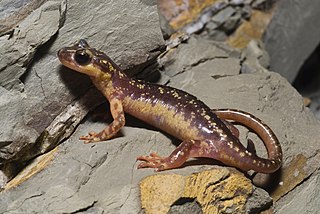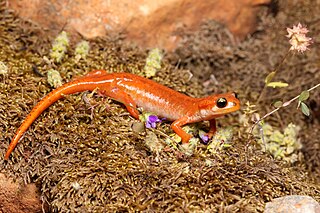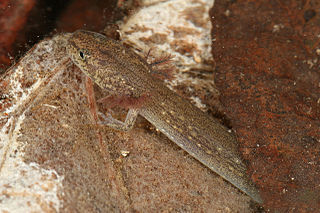Lyciasalamandra antalyana, the Anatolia Lycian salamander, is a species of salamander in the family Salamandridae found only in Turkey. Its natural habitats are temperate forests, Mediterranean-type shrubby vegetation, and rocky areas. It is threatened by habitat loss.

Lyciasalamandra is a genus of salamanders in the family Salamandridae. They are native to southwestern coast of Turkey and nearby Aegean Islands (Greece). As of early 2018, all species in the genus are threatened. The common name Lycian salamanders has been coined for them.
Lyciasalamandra billae, the bay Lycian salamander, is a species of salamander in the family Salamandridae found only in Turkey. Its natural habitats are temperate forests and Mediterranean-type shrubby vegetation. It is threatened by habitat loss.
Lyciasalamandra fazilae, or Fazila's salamander, is a species of salamander in the family Salamandridae found only in Turkey. Its natural habitats are temperate forests and Mediterranean-type shrubby vegetation. It is threatened by habitat loss.
Lyciasalamandra flavimembris, the Marmaris Lycian salamander or Marmaris salamander, is a species of salamander in the family Salamandridae. It is endemic to Turkey and is found along the southwestern Anatolian coast between Marmaris and Ula. It was first described as subspecies of Mertensiella luschani, now Lyciasalamandra luschani.

Lyciasalamandra helverseni, the Karpathos salamander, is a species of salamander in the family Salamandridae found only in Greece. Its natural habitats are Mediterranean-type shrubby vegetation and rocky areas.

Luschan's salamander or Lycian salamander is a species of salamander in the family Salamandridae. It is found in the southwestern Anatolia in Turkey and in adjacent Greece.

The Odaigahara salamander is a species of salamander in the family Hynobiidae. It is endemic to Japan. Its natural habitats are temperate forests, rivers, and freshwater springs. This species is threatened by habitat loss.
The Hakuba salamander or Japanese mountain salamander is a species of salamander in the family Hynobiidae. This salamander is also synonymous with the mountain salamander. It is endemic to Japan. Its natural habitats are temperate forests, rivers, swamps, freshwater springs, and plantations. It is threatened by habitat loss.
The Oki salamander is a species of salamander in the family Hynobiidae, endemic to Japan. Its natural habitats are temperate forests, rivers, and plantations. It is threatened by habitat loss.
The amber salamander, amber-colored salamander, tortoiseshell salamander, or Stejneger's oriental salamander is a species of salamander in the family Hynobiidae, endemic to Japan. Its natural habitats are temperate forests and rivers. It is threatened by habitat loss.

The Tokyo salamander is a species of salamander in the family Hynobiidae, endemic to Japan. Its natural habitats are temperate forests, freshwater springs, arable land, irrigated land, and canals and ditches. It is threatened by habitat loss.
The Salado Springs salamander is a candidate species of salamander in the family Plethodontidae. It is endemic to the vicinity of Salado, Texas.
The Blanco River Springs Salamander is a species of salamander in the family Plethodontidae. It is endemic to springs in the Blanco River watershed in central Texas, United States.

The Jollyville Plateau salamander is a species of salamander in the family Plethodontidae. It is also known as the Tonkawa Springs salamander. It is endemic to Travis and Williamson counties, Texas, United States. This species is perrenibranchiate, retaining its gills throughout life.
The Big Levels salamander is a species of salamander in the family Plethodontidae. It is endemic to Virginia in the eastern United States. The specific epithet sherando is from Sherando Lake in the George Washington National Forest. It common name is from the Big Levels area of southeastern Augusta County, Virginia, a series of flat to gently rolling mountain tops in the Blue Ridge Mountains, where it was found.

The southern Appalachian salamander, scientific name Plethodon teyahalee, is a species of salamander in the family Plethodontidae.
Pseudoeurycea goebeli is a species of salamander in the family Plethodontidae. It is found in Guatemala and Mexico. Its natural habitat is subtropical or tropical moist montane forests. It is threatened by habitat loss.
The Xingan salamander is a species of salamander in the family Hynobiidae, endemic to China: it is only known from its type locality, Mao'ershan in the Xing'an County, Guangxi. Its natural habitats are marshes and the surrounding forests. It is a quite a common species during the breeding season (November–February). It is threatened by habitat loss and, living close to the summit of Mao'ershan at around 2,000 m (6,600 ft) asl, by climate change. It occurs within the Mao'ershan National Nature Reserve.









